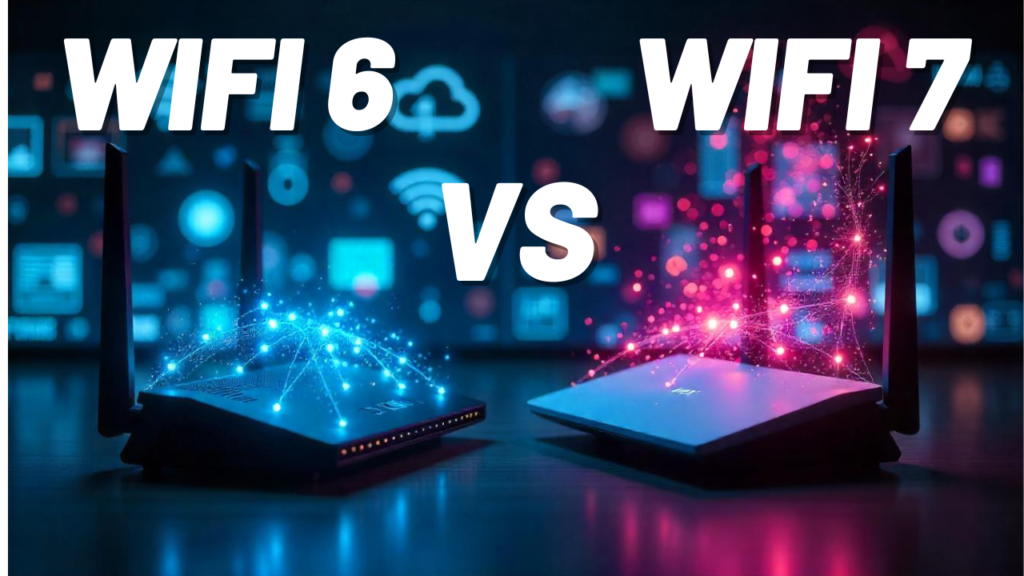
Introduction
With technology evolving rapidly, wireless internet standards keep improving to meet the growing demands for speed and connectivity. But what is the difference between WiFi 6 and 7, and why does it matter? WiFi 7, also known as 802.11be, is the latest advancement in wireless networking, offering faster speeds, lower latency, and better performance in crowded environments. Let’s dive deeper into how WiFi 7 compares to WiFi 6 and what upgrades it brings to your devices.
What Is WiFi 7?
WiFi 7 builds on the foundation of WiFi 6 (802.11ax) and introduces significant upgrades in speed, efficiency, and connectivity. Designed for environments where multiple devices connect simultaneously, WiFi 7 aims to provide seamless, high-performance internet for homes, offices, and public spaces.
What Is the Difference Between WiFi 6 and 7?
Speed:
- WiFi 6 offers speeds up to 9.6 Gbps.
- WiFi 7 can reach speeds exceeding 40 Gbps, making it ideal for high-bandwidth activities like 8K streaming and AR/VR applications.
Channel Width:
- WiFi 6 uses channel widths of up to 160 MHz.
- WiFi 7 doubles this to 320 MHz, reducing congestion and boosting performance in crowded networks.
Multi-Link Operation (MLO):
- A game-changer exclusive to WiFi 7, MLO allows devices to connect to multiple bands (2.4 GHz, 5 GHz, and 6 GHz) simultaneously, ensuring consistent performance and minimal interruptions.
Target Wake Time (TWT):
- TWT (Target Wake Time) allows devices to “sleep” when idle, reducing power usage and improving efficiency.
- While available in WiFi 6, WiFi 7 further refines this feature by allowing more precise scheduling for connected devices, especially IoT gadgets like smart thermostats and sensors. This means longer battery life for your devices and more efficient energy use in networks with many low-power gadgets.
Tabela de Comparação: WiFi 6 vs WiFi 7
| Feature | WiFi 6 | WiFi 7 |
|---|---|---|
| Maximum Speed | Up to 9.6 Gbps | Over 40 Gbps |
| Channel Width | Up to 160 MHz | Up to 320 MHz |
| Multi-Link Operation (MLO) | Not available | Allows simultaneous multi-band use |
| Latency | Lower latency than WiFi 5 | Ultra-low latency for real-time apps |
| Target Wake Time (TWT) | Improves battery life in devices | Even greater efficiency, extending device lifespan |
What Do You Need to Use WiFi 7?
To take advantage of WiFi 7, both your router and device must support this new standard. Even if you upgrade your router, older devices will still connect using WiFi 6 or earlier standards, limiting the benefits of WiFi 7. If you’re planning to upgrade, ensure your laptop, smartphone, or other gadgets are WiFi 7-compatible to experience the full potential of this technology.
When Will WiFi 7 Be Available?
WiFi 7 is already making its debut in flagship devices like the iPhone 16, released in 2024. While most devices and routers currently support WiFi 6, manufacturers are quickly adopting WiFi 7 to meet growing demands for ultra-fast and reliable internet. WiFi 7-compatible routers are expected to become mainstream by 2025, allowing more users to benefit from this advanced technology. If you’ve recently upgraded to an iPhone 16 or other WiFi 7-enabled device, you’ll need a WiFi 7 router to unlock its full potential.
Why Upgrade to WiFi 7?
If you rely on high-speed internet for streaming, gaming, or remote work, WiFi 7 could revolutionize your experience. The difference between WiFi 6 and 7 lies in its ability to handle more devices and deliver consistent, ultra-fast internet speeds without lag or buffering.
Conclusion
So, what is the difference between WiFi 6 and 7? In short, WiFi 7 represents a leap forward in speed, efficiency, and reliability. While WiFi 6 already offers robust performance, WiFi 7 is designed to meet the demands of tomorrow’s digital lifestyle. Just remember: to enjoy WiFi 7, both your router and devices need to be compatible. Whether you’re a tech fan or just want faster internet, WiFi 7 is worth keeping an eye on.

1 thought on “What Is the Difference Between WiFi 6 and 7?”